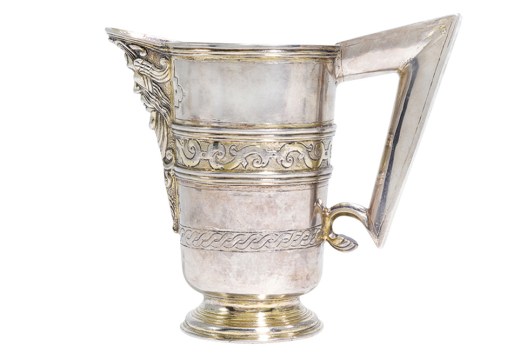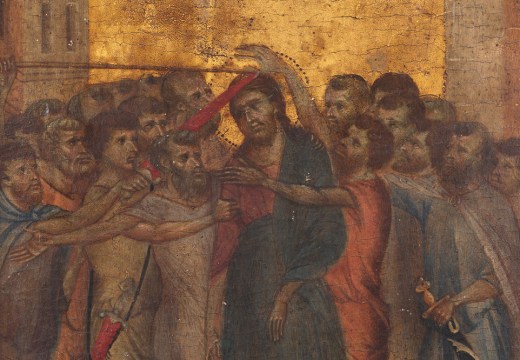From the January 2023 issue of Apollo. Preview and subscribe here.
In 2014, the private view of TEFAF Maastricht produced an important acquisition for the Rosalinde and Arthur Gilbert Collection which was transferred to the Victoria and Albert Museum from Somerset House in 2008. The leading silver dealer Koopman Rare Art displayed the spectacular silver bowl and cover, a gift in 1731 from the Hanoverian monarch George II to his god-daughter Emilia, which had descended in the family until 1984, when it was sold. Emily, as she was known, was the second daughter of the leading courtier, gentleman of the bedchamber and master of the horse Charles Lennox, 2nd Duke of Richmond and Lennox. His wife Sarah was lady of the bedchamber to Queen Caroline.
A Louis XV-style confection designed by Edward Feline, the circular bowl is supported on four scroll feet, with foliate cast and chased handles bearing a crowned lion and prancing chained and collared unicorn, the heraldic supporters of the royal coat of arms. A lion surmounts the royal crown that serves as both handle and finial to the cover. The bowl is decorated with lace-like pierced strapwork burnished against a matted ground, a technique repeated in the alternating strapwork panels that adorn the cover. Such contrasting textures would have glimmered in candlelight.
An order for silver to be supplied by the Royal Jewel House to the 2nd Duke of Richmond specifies ‘Two Hundred Ounces of gilt plate as a gift from his Majesty at the Christening of his Child, to be made into such vessels and after such a fashion as his Grace shall direct’. This unusual choice for a christening gift was evidently dictated by the duke’s desire to display royal favour by ensuring that the resulting vessel clearly displayed the royal heraldic supporters; they flank the coat of arms engraved in the central scroll cartouche. A contemporary of the better-known Paul de Lamerie, Edward Feline was apprenticed in 1709 to Huguenot goldsmith Augustin Courtauld, who lived and worked near St Martin-in-the-Fields. Feline registered his maker’s mark at Goldsmiths’ Hall 11 years later when he had established his own workshop in Rose Street, Covent Garden. The christening gift, as a royal commission, is not hallmarked; it was not tested at Goldsmiths’ Hall for the proportion of silver content in the alloy. Instead it bears four impressions of Feline’s maker’s mark which betray his French origin. Its triple tier form is characteristically French; his initials, E and F, are surmounted by a pelican feeding her young with drops of her own blood and a mullet (five-pointed star) below. The cup is inscribed underneath ‘Lady Emilia Lenos (sic) Oct. 25th 1731’ recording the date of baptism, three weeks after the child’s birth on 6 October.
Lady Emilia was baptised at St Margaret’s, Westminster, the parish church closest to the family’s London home, Richmond House, Whitehall. After the ceremony, cakes ordered by the house steward for the occasion were served to eight guests. Emilia’s other godparents were Princess Amelia, George II’s daughter, in whose honour the baby was named, and Camilla, Countess of Tankerville, who, living at Uppark, was a country neighbour of the Duke of Richmond at Goodwood. As Emilia grew, she may have associated the heraldic animals on this royal gift with the real lioness in the menagerie her father had assembled at the family’s Sussex home.
Emilia cherished her christening gift and took it to Ireland when in 1747, at the age of 15, she married James FitzGerald, 20th Earl of Kildare, later Duke of Leinster. The couple, who lived at Leinster House, Dublin, and at Carton, County Kildare, had 19 children – although only half of them lived to adulthood – so it is possible that the bowl was used for those successive baptisms. In 1856, the bowl acquired an Irish silver liner marked for Robert Smith of Wicklow Street, Dublin. This suggests that it was used on the dining table for serving soup, probably in the context of the celebrated Leinster silver dinner service. In the mid 18th century, the dining table at Leinster House was so heavily laden with silver that the English playwright Samuel Foote felt he was dining in a silversmith’s shop.
Did Emilia’s father deliberately select a vessel from which soup could be served? A fashionable introduction from France, ‘Soupe’ dishes were first issued by the Jewel House in the 1690s; William III had a ‘new Terreen or Soupe Dish’ delivered in July 1701. The table layouts in The Modern Cook (1733), the culinary classic by Vincent La Chapelle, head chef to Philip Stanhope, 4th Earl of Chesterfield, indicate that soup tureens normally had stands which would protect the damask tablecloth from spillage. La Chapelle devoted 79 pages to recipes for soups. This royal christening gift may have had a stand, or an earlier liner, since the present weight of the bowl and cover is 159 ounces, 41 ounces less than the Jewel House allocation.
The gift is not listed in the recently published 1818 inventory of the contents of Carton House; it was probably kept in Dublin. By 1871, described as ‘the beautiful Christening vase which was presented by George II to his god-daughter Lady Emily Lennox’, it was admired as an ornament.
From the January 2023 issue of Apollo. Preview and subscribe here.
Unlimited access from just $16 every 3 months
Subscribe to get unlimited and exclusive access to the top art stories, interviews and exhibition reviews.














![Masterpiece [Re]discovery 2022. Photo: Ben Fisher Photography, courtesy of Masterpiece London](http://www.apollo-magazine.com/wp-content/uploads/2022/07/MPL2022_4263.jpg)
It’s time for the government of London to return to its rightful home